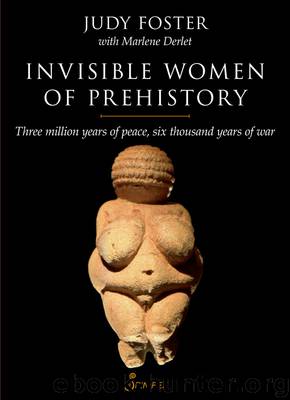Invisible Women of Prehistory by Marlene Derlet

Author:Marlene Derlet
Language: eng
Format: epub
Publisher: Spinifex Press
Published: 2019-10-09T16:00:00+00:00
1. Cylindrical stone with human head (perhaps a pestle?) 20,000–10,000 BP; and an incised pebble with female image
(Source: Barnes, Gina, 1993)
All line drawings © Judy Foster, 2013
Japan
Evidence shows that the Palaeolithic period in Japan lasted from 50,000 BP until 18,000 BP and the people were hunters, fishers and gatherers who used micro-blade stone tools. Little else is known about them. Jomon pottery originated with the ancestors of the present-day Ainu ‘aboriginal’ people of Japan about 18,000 BP.72 They have a legend which says they have lived there for 100,000 years (for almost as long as the Indigenous people say they have been in Australia).73 DNA tests indicate that the Ainu may have originally come from Tibet, the Andaman Islands, Mongolia, or even Taiwan.74 (There have been suggestions that 10,000-year-old skeletal evidence of early Ainu people resembles that of indigenous New Guinean and Australian people.)75
The indigenous Ainu people lived in the northern and central islands and their culture and language was different to that of the Jomon people. They were mainly hunter/fisher people with an animist religion. Their houses were built from cogon grasses, bamboo grass, or bark, and were placed alongside rivers and the coastline. Typical houses had reed-thatched roofs, and were seven metres by five long with three windows, a central fireplace, and a storage area at the western entrance. People usually sat on woven reed or flag mats. The largest house in a settlement was used as a communal meeting place.76 Ainu clothes were made from feathered bird-skin, tree bark (barkcloth), and hides of bear, deer, fox, seal and dog; men’s hats were made from wood fibre with partially shaved wood bundles, and women’s hats consisted of an embroidered headband.
In terms of societal structures, there were various forms of marriage: that of a child “promised by arrangement”, marriage “based on mutual consent of both sexes”,77 or sometimes a daughter was given a room of her own to receive her followers, one of whom the parents would choose for her to marry. Men and women were considered to be adult at 15 to 16 years of age; girls received their first tattoos at 12 to 13 years of age, and the remainder by adulthood, when they were to marry.
Conflict resolution was mediated by a number of clan elders who decided suitable punishment. Ainu people also hunted in groups within their own territory; sometimes several village units hunted within joint territories. They were peaceful people until the arrival 3,500 years ago of the Yayo people.
The Ainu have: the ‘sun goddess’ Chup-Kamu (who was originally the moon goddess); Fuji, an ancient ‘fire goddess’ as represented by Mount Fuji; Kamui-fuchi, ‘Lady Hearth’, the Ainu Supreme Ancestress, a deified tribal mother, or spirit of ‘female productivity and the home’; and Onne-chip-kamui, ‘Grandmother Tree’.
The Jomon people were similar in appearance to modern Ainu people, descendants of an ancient Palaeo-Asiatic lineage which may also have included the Jeulmun people of Korea. This date is in accord with Luigi Cavalli-Sforza’s genetic evidence in 2000 concerning the likeness of northern Chinese to Manchurians, Koreans and Japanese.
Download
This site does not store any files on its server. We only index and link to content provided by other sites. Please contact the content providers to delete copyright contents if any and email us, we'll remove relevant links or contents immediately.
| Civilization & Culture | Expeditions & Discoveries |
| Jewish | Maritime History & Piracy |
| Religious | Slavery & Emancipation |
| Women in History |
Cecilia; Or, Memoirs of an Heiress — Volume 1 by Fanny Burney(32078)
Cecilia; Or, Memoirs of an Heiress — Volume 3 by Fanny Burney(31470)
Cecilia; Or, Memoirs of an Heiress — Volume 2 by Fanny Burney(31420)
The Secret History by Donna Tartt(18225)
Sapiens: A Brief History of Humankind by Yuval Noah Harari(13999)
Leonardo da Vinci by Walter Isaacson(12815)
The Radium Girls by Kate Moore(11639)
Sapiens by Yuval Noah Harari(5130)
How Democracies Die by Steven Levitsky & Daniel Ziblatt(4970)
The Wind in My Hair by Masih Alinejad(4852)
Homo Deus: A Brief History of Tomorrow by Yuval Noah Harari(4694)
Endurance: Shackleton's Incredible Voyage by Alfred Lansing(4518)
Man's Search for Meaning by Viktor Frankl(4299)
The Silk Roads by Peter Frankopan(4277)
Millionaire: The Philanderer, Gambler, and Duelist Who Invented Modern Finance by Janet Gleeson(4116)
The Rape of Nanking by Iris Chang(4025)
Hitler in Los Angeles by Steven J. Ross(3803)
Joan of Arc by Mary Gordon(3797)
The Motorcycle Diaries by Ernesto Che Guevara(3795)
